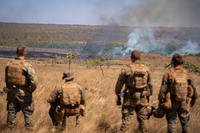PACIFIC OCEAN -- U.S. Coast Guard Law Enforcement Detachment Team (LEDET) 101 embarked and integrated with Sailors on the Oliver Hazard Perry-class guided-missile frigate USS Gary (FFG 51) for training and anti-drug smuggling operations off the California coast, Aug. 26 - 29.
"We are currently supporting counter-smuggling operations by providing law enforcement capabilities to Third Fleet Navy platforms in known drug and migrant transit corridors," said Coast Guard Chief Maritime Enforcement Specialist Chris Sinclair, officer-in-charge of LEDET 101, assigned to Pacific Tactical Law Enforcement Team (TACLET) San Diego.
The U.S. Navy and Coast Guard team participated in joint training evolutions including communications troubleshooting and small boat operations.
During small boat operations, Gary Sailors manned and lowered a rigid hull inflatable boat (RHIB) alongside the ship. There, members of the LEDET embarked the RHIB, where they performed communication checks and evasive maneuvers.
"Our evolutions went great," said Boatswain's Mate 3rd Class Isaac Abakah. "There were no problems integrating deck department personnel with the [Coast Guardsmen]."
The current underway aboard Gary is not the first operation where a LEDET has embarked a 3rd Fleet ship.
"In June, the Coast Guard came out to the Gary to participate in integrated training with our visit, board, search and seizure (VBSS) team," said Lt. Cmdr. Bob Jones, executive officer of Gary. "The training and integration between both branches was successful."
The deployment of LEDETs on naval vessels has become more and more prevalent in recent decades.
"We do integrated training as often as we can," said Sinclair. "I have been on three frigates and the USNS Joint High Speed Vessel Swift performing anti-piracy and anti-drug trafficking missions."
TACLETS are designed to be able to conduct a variety of joint missions to safeguard the public by enforcing U.S. laws across a full spectrum of maritime response situations in support of Coast Guard, National Security and law enforcement operations.
According to Sinclair, federal law requires a LEDET to embark Navy ships when participating in a law enforcement role. The Navy vessel, then, becomes a Coast Guard asset once law enforcement operations take place.
"[The Coast Guardsmen] are experts in law enforcement," said Jones. "We coordinated beneficial training, and we will continue our proficiency in working with the U.S. Coast Guard and Third Fleet assets."
Joint interagency and international relationships strengthen U.S. 3rd Fleet's ability to respond to crises and protect the collective maritime interests of the U.S. and its allies and partners.

























